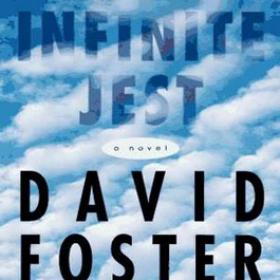Infinite Jest By David Foster Wallace

4.5/5
Never judge a book by its cover…or its physical dimensions.
There is a debate that pertains to books such as David Foster Wallace’s Infinite Jest regarding the strained relationship between pop culture and high-end literature. Should fiction entertain or intellectually stimulate? Can it do both? Can the proverbial nerd in the AV club ever hang out with the cheerleaders and the jocks? Does a 1000 + page monster such as Wallace’s have any business being in a pop culture forum, like this website? Aren’t books like this just laborious, postmodernist, esoteric fodder (whatever the hell that means) for literary critics and quirky college profs anyways?
With the recent attention the book has been getting, one could argue that Infinite Jest has begun at least to splinter its way into the popular culture’s subconscious. If you picked up the July 20th issue of Newsweek, you might have noticed an article about the website, infinitesummer.org, that hopes to bridge the gap between Infinite Jest and casual readers who may feel they lack the intellectual caliber or the stubborn temperament to tackle the book…or they think that having to read anything this size would have to be like watching paint dry (in slow motion). This website helps readers break the book into 75 page palatable chunks over a 3 month period with weekly discussion forums. The website even has groups dedicated to the book on Facebook and Twitter, arguably the two best litmus tests of popularity, right?
But is this book, more than a decade old now, deserving of all this recent fanfare, or is its rising popularity just an after shock in the wake of Wallace’s suicide last September? It’s a valid argument. You probably weren’t listening to “Man in the Mirror” ad nauseum until a couple of weeks ago either. Is this infinite summer just a fad, just phenomena of our culture’s fascination with the dead? Was that way too cryptic a question? Will it inevitably be dropped like the ton of bricks that it weighs once the new American Idol starts?
Admittedly, the book is not just dauntingly long but it is also thematically complex, with multiple changes in narrative between numerous characters, plots within subplots, and considerable jumps in setting and time (whole chapters can in fact be found among the books 300 + footnotes). To ask someone who has read it to provide you with a summary of the book’s plot would prove fruitless and confounding. This someone would begin rambling on about something concerning the beginning of subsidized time (i.e. instead of 2009 you would now have “The Year of the Whopper,” or “The Year of the Depend Adult Undergarment); some uppity tennis academy where 12-15 year old students play a game based upon geopolitical nuclear warfare scenarios to practice proper form when lobbing tennis balls; a doomsday video threatening to drive everyone insane; wheelchair-bound assassins who are intent on abducting this video in order to demand the separation of Quebec from the recently formed corporation of The United States, Canada, and Mexico…
Inevitably you will just be told to go read the damn thing.
You do not have to dig as deep, as some may choose, into the complexities of the book in order to enjoy and be moved by it however. Wallace said in an interview with Charlie Rose (1997) that a novel asks much more of readers than other pieces of art—specifically in regards to time (something many of us cannot or are just not willing to sacrifice in the era of sound bytes, iphones and Michael Bay). Therefore there is a greater pressure on modern authors to deliver the goods, especially when he or she is asking for at least a month. But do not let this review lead you to think that you will be forever bored and confused during this time; far from it. Wallace does deliver and, as long as you are paying attention, you will be constantly humored and fascinated by just how witty, smart and profound this guy was. Its not a difficult book, per se, it is just really, really long. Besides, you can probably do all this on the comfort of your iphone now.
And within the seemingly endless turning of pages and footnotes a reader will find the delicate balance between entertainment and intellectual enlightenment. The second chapter humorously displays a character’s ritualistic house cleansing after huge pot binges, only to see the character constantly relapse and have to restock the house with necessary items such as new bongs, snack food, petroleum jelly and $1250 of THC. Wallace even has one character come up with an intricate math equation with accompanying x/y chart to prove that the novel’s main character, Hal Incandenza, is undeniably a dick. And underlying all this periodic humor there is a deeply touching (and haunting) theme of the loss and depression felt by many of Wallace’s characters. This is especially true in one part where Wallace describes the complexities of depression. Arguably there is no clearer, sincere or ominous explanation of what can drive a person to commit suicide, or in Wallace’s fancy smancy talk, felo de se. Any reader who can see past the physical volume of this book will find a comical read as well be provided with a VIP glimpse into a brilliant, albeit tragic, mind.
But is all this hoopla surrounding Infinite Jest this summer akin to the attention Michael Jackson’s recordings are now receiving because of his own untimely death? Probably. Will this attention last and will Jest take its place among the hierarchy of literary classics? Right now, who really cares? Even the geeks sometimes get their time in the limelight. Should you spend the rest of your summer reading it? Sure, why the hell not; its rerun season anyways. If nothing else it will at least improve your vocabulary.
RELATED ARTICLES
Get the most-revealing celebrity conversations with the uInterview podcast!





Leave a comment